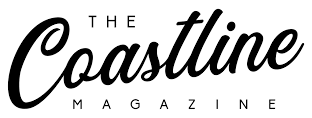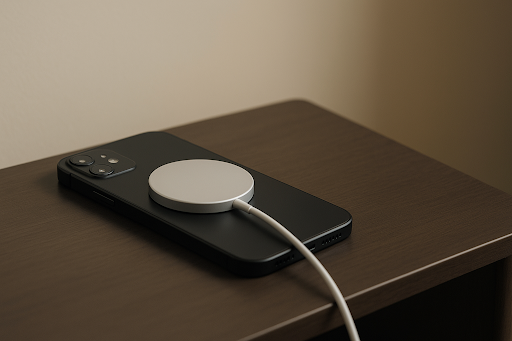As part of the iPhone 12 launch in 2020, Apple promised faster wireless charging and magnetic, easier alignment with the phone. MagSafe chargers, however, have been found to warm up significantly during use. Is that heat dangerous, and does that heat interfere with phone and battery functioning? In this article, we take a closer look at the MagSafe charger, its wireless charging heat, and how it compares to other wireless chargers. We also provide benchmarks and suggestions on how to minimise heat. Finally, we explain the optimal temperature for MagSafe charging.
Understanding the Technology Behind MagSafe Chargers
What Distinguishes MagSafe?
MagSafe chargers are not simply Qi pads with magnets affixed to them. Apple’s MagSafe wireless charging system utilises a circular pattern of strong magnets surrounding the charging coil to attach iPhone models 12 and newer. This guarantees that the charging coil within the cellphone and the charger’s coil align perfectly to optimally overlap and maximise charge during transfer. With MagSafe’s 15W charging capacity for compatible iPhones, it provides a compelling advantage over Qi charging for up to 7.5W on non-Apple devices. MagSafe’s 15W advantage maximally benefits users who prioritise expedience and efficiency.
Built-in alignment features also reduce the chances of misplacement, a common problem with traditional wireless chargers that results in diminished charging efficiency. Apple’s solution: improved convenience. In tandem with these enhancements to user experience, however, Apple’s solution also leads to the generation of excess heat. With increased efficiency, the phone charger fee system also drives higher current. Current flow, in turn, leads to heating due to the unavoidable byproducts of physics and electrical resistance.
MagSafe Chargers and the Generation of Heat
Wireless charging systems convert electrical energy into a magnetic field that the receiving device converts back into electrical energy. This process is less efficient than plugged-in systems. Energy, in the form of heat, “leaks” due to coil resistance, nearby metal, eddy currents, and electromagnetic losses. MagSafe’s additional 15W over traditional Qi chargers also results in increased heat.
Furthermore, the aluminium exterior of the MagSafe puck helps in the even distribution of heat across its surface, which is useful in speeding up the dissipation of heat. Although this reduces the amount of heat the puck case traps, you will still notice the warmth on your desktop or bedside table.
How iPhones and MagSafe Products Work Together
To maintain the battery’s health, the iPhone’s operating system undertakes a temperature check for the battery on a continuous basis. When the internal sensors of the phone detect elevated temperatures beyond a certain threshold, which is normally 45-50°C, the system may reduce the current, slow down the charge, or even halt the process. This enables an iPhone and MagSafe charger to dynamically manage heat, which helps to reduce the temperature of both devices, but in the case where the devices are hot, it can delay the charging.
Is it Normal for a MagSafe Charger to Heat Up?
Standard Surface Temperatures for a MagSafe Charger
You can expect the surface temperatures of MagSafe chargers to lie between 35-45°C in most environments. When enclosed, as in a leather pouch, or during hot weather, the temperatures can exceed 50°C. While the temperature may feel hot to the touch, it is typically Apple’s tolerance.
When Worrying Is Justified
In the instance that the surface of a MagSafe puck routinely surpasses a temperature of 50°C, or if charging suspends with a “Charging on Hold” message even after a period where the puck has cooled down, there may be a hardware issue, for example, a dust blockage on the connector or a defective cable, or a non-certified or underpowered charger is being used. Chronic temperatures of 55°C have the potential to harm the charging cable or puck due to electrical resistance, which may compromise the long-term health of the battery.
How Much Temperature Is Dangerous? Manufacturer Temperature Guidelines
Charging Guidelines
According to their support articles, Apple recommends that users charge their iPhone when the ambient temperature is between 0°C and 35 35°C. While the charger is able to heat beyond 35°C, the iPhone’s internal management system will defend the battery when the internal temperature of the cell exceeds approximately 45°C. The charge rate will be tapered significantly beyond these temperature thresholds.
Insights from Independent Evaluations
Review platforms such as iFixit and The Wirecutter have conducted independent evaluations of MagSafe chargers and their surface temperatures. iFixit and The Wirecutter’s evaluations show that surface temperatures of MagSafe chargers do not exceed 47 °C during 15W charging. This is well within the safe operating range. These evaluations suggest that as long as users utilise Apple-certified accessories and proper power adapters, MagSafe chargers should not pose any hazards during prolonged phone use.
MagSafe Charger Comparison to Other Wireless Chargers
MagSafe vs. Qi Chargers
Generic Qi chargers have a maximum power output of 15W for Android phones and 7.5W for iPhones. Many cheaper models of Qi chargers offer a maximum output of 5W. While a Qi charger may have lower power output, it also produces less heat, allowing for a 7.5W Qi pad to charge at a lower MagSafe temperature. MagSafe chargers, on the other hand, utilise a magnetic lock and have a higher power output, allowing users to charge at a higher temperature but offering improved charging predictability as a tradeoff.
Misplaced alignment in Qi chargers may lead to increased battery coil resistance, allowing for localised heating or complete charging blockage, thus making MagSafe chargers more reliable.
Pros and Cons in Heat Management
MagSafe Charger
- Pros: Easy alignment, greater power, seamless Apple integration, reduced energy loss, and less energy wasted.
- Cons: Requires Apple-certified charger, surface temperatures of 45-50 °C.
Standard Qi Pad
- Pros: Lower temperature (35-40 °C), lower cost, greater compatibility, and use with multiple devices.
- Cons: Slower charging with iPhone, manual alignment required, potential for hotspot danger.
Heat Reduction Tips for MagSafe Charging
Best Position, Charging Placement, and Ventilation
Do not place MagSafe chargers on fabric for charging or in enclosed areas. Wooden or glass surfaces enhance cooling and heat dissipation, keeping the temperature lower. Charging beneath pillows or inside desk drawers should be avoided. Even minimal spacing behind the charger aids in circulation, cooling the surface temperature.
Using Certified Accessories
Always use MagSafe pucks with Apple 20W USB-C power or USB-C PD 9V/2.22A output compatible chargers. Weaker or fake power adapters add extra heat by introducing electrical resistance. Use of MFi‑certified cables supports power delivery while lowering the risk of hotspots.
Optimised Firmware Functionality and Its Impact on Battery Health Management
Regularly updating your iPhone’s software makes sure you take advantage of Apple’s best practices for managing your device’s heat and battery. Enabling “Optimised Battery Charging” in Settings > Battery > Battery Health makes sure that charging will slow down past 80% and heat is detected, which decreases battery strain. If you tend to charge your device overnight, you might wish to turn off full-speed MagSafe charging for a lower temperature, slower wired charge.
My Experiences: Using MagSafe Charger for the First Time
My initial experience unboxing a MagSafe charger was the excitement of how quickly it was to use. The first con was that a quarter of an hour into using it, the charger would heat up significantly. To begin with, it was a valid concern that the charger would lead to overheating the battery. But, using a USB-C power meter and laser infrared thermometer, I was able to see that the puck would heat up to a steady 42 degrees, which is acceptable. Switching to a certified 20W PD adapter helped significantly, and just using a silicon charger adapter helped 5 degrees on the puck temperature. All in all, this helped me feel at ease without worrying about the battery and seeing iOS stats showed no battery decline with consistent usage helped.
Applying the theories learned in class, this experiment demonstrated the utilisation of precision methods to increase the efficiency of gastight systems, as well as the engineering strategies to enhance airflow, ways to refine existing systems, and iPhone’s battery efficiency preservation protocols from high-watt charges.
Conclusion
Despite the fact that MagSafe chargers offer a convenient way to power devices wirelessly, the frequent overheating issues make it necessary to use traditional Qi chargers. MagSafe’s efficiency as a charger can be further improved by utilising low-power adapters, managing airflow, and implementing the right software. With these tips in mind, MagSafe can be relied on as a simple and convenient addition to technology in day-to-day tasks as long as the temperatures remain reasonable and stay within the threshold of overheating.
FAQ
What are the chances of a MagSafe charger overheating and, in turn, damaging the iPhone?
Not on their own. Apple’s thermal management systems automatically slow down or halt charging when the battery temperature is estimated to be near 45 °C. Provided there is a MagSafe charger and 20W USB-C power adapter in use, the chances of long-term battery overheating damage are non-existent.
Does the use of a MagSafe case influence the temperature while charging?
Warming up a phone while charging will not be considerably altered by the use of the thin MagSafe cases, which are certified by Apple. Nevertheless, MagSafe cases with greater thickness or those that contain metals may insulate warmth and result in the phone and charger overheating. MagSafe cases are recommended to be used with bulkier phone cases or for the latter to be removed during charging to maximise efficiency.
How can I know when to stop charging my phone?
Examine your setup and troubleshoot the charger if the temperature rises above 50 °C and the MagSafe puck temperature stays at a constant 50 °C, or if iOS notifies you of Charging on Hold during reasonable temperatures. Ensure the charger is not exceeding the recommended power adapter wattage, the cable used is MFi certified, and improve the charger temperature and airflow. Persistent heat after these resolutions will require intervention despite the provided changes.
How do third-party MagSafe chargers compare with Apple’s in terms of safety?
Apple-certified third-party MagSafe chargers are Apple’s ‘Made for MagSafe’ approved, which means these undergo product safety checks for each of the magnet, power delivery, and heat scan. Cheap unendorsed copies often miss critical components like proper temperature or current management systems, which increase the chances of overheating. It is safer to avoid such products and prefer MagSafe-certified products from reputable producers.

